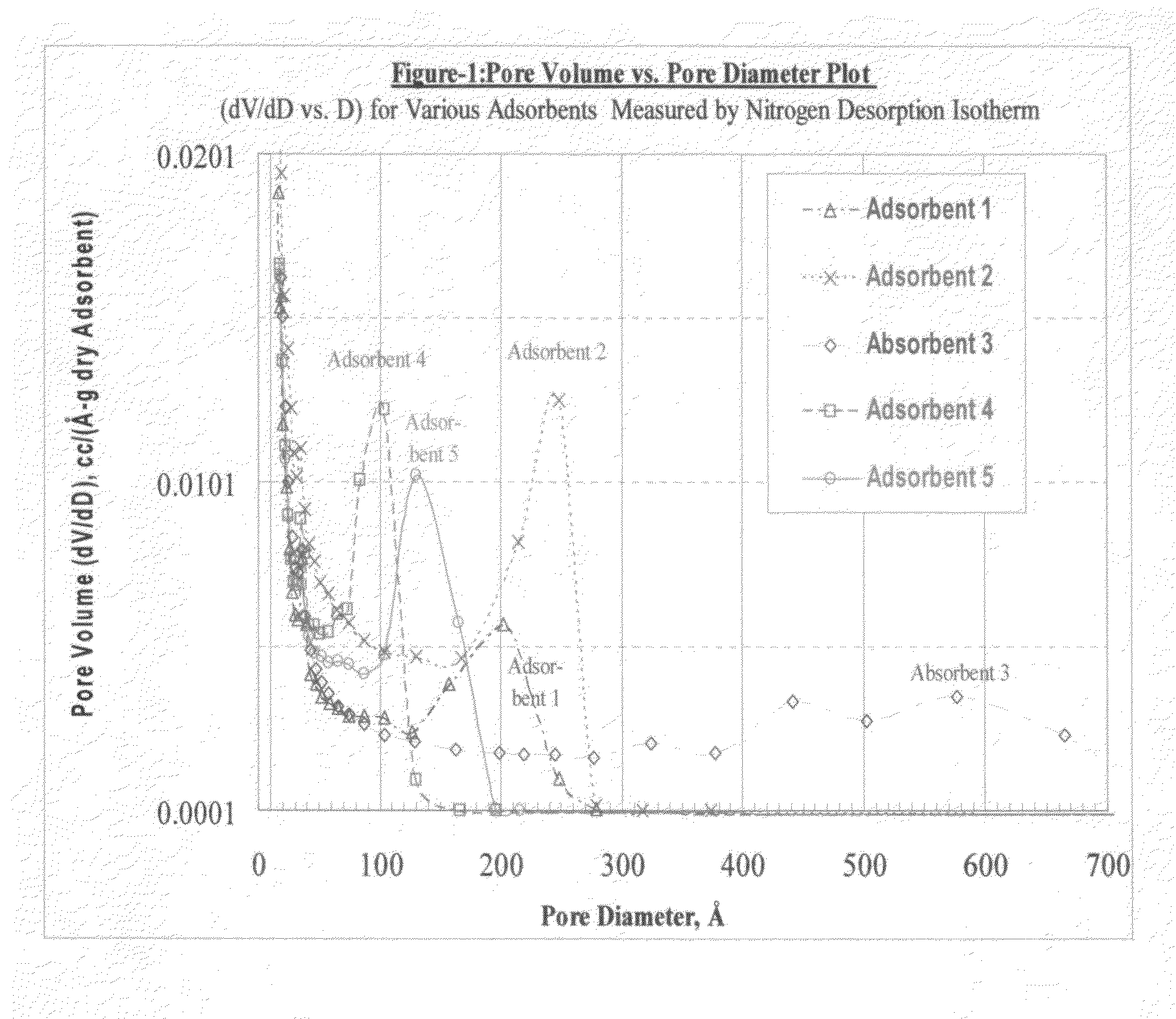Size-selective polymer system
- Summary
- Abstract
- Description
- Claims
- Application Information
AI Technical Summary
Benefits of technology
Problems solved by technology
Method used
Image
Examples
example 1
Adsorbent Syntheses
[0061]The synthesis process consists of (1) preparing the aqueous phase, (2) preparing the organic phase, (3) carrying out the suspension polymerization, and (4) purifying the resulting porous polymeric adsorbent product. The aqueous phase compositions are the same for all the polymerizations. Table 1A lists the percentage composition of the aqueous phase and Table 1B gives the material charges typical for a five (5) liter-reactor polymerization run.
TABLE 1AAqueous Phase CompositionWt. %Ultrapure Water97.787Dispersing Agent: Polyvinylalcohol0.290Monosodium Phosphate0.300Disodium Phosphate1.000Trisodium Phosphate0.620Sodium Nitrite0.003
TABLE 1BMaterial Charges for a Typical Five(5) Liter-Reactor Polymerization RunVolume of Aqueous Phase1750.00mlDensity of Aqueous Phase1.035g / mlWeight of Aqueous Phase1811.25gVolumetric Ratio, Aqueous Phase / Organic Phase1.05Volume of Organic Phase1665.0mlDensity of Organic Phase0.84093g / mlWeight of Organic Phase, Excluding Initiator ...
example 2
Pore Structure Characterization
[0064]The pore structures of the adsorbent polymer beds identified in TABLE 1C were analyzed with a Micromeritics ASAP 2010 instrument. The results are provided in GRAPH 1 where the pore volume is plotted as a function of the pore diameter. This graph displays the pore volume distribution across the range of pore sizes.
[0065]The pore volume is divided up into categories within pore size ranges for each of the five adsorbent polymers and these values are provided in TABLE 2. The Capacity Pore Volume is that pore volume that is accessible to protein sorption and consists of the pore volume in pores larger than 100 Å diameter. The Effective Pore Volume is that pore volume that is selectively accessible to proteins smaller than 35,000 Daltons and consists of pore diameters within the range of 100 to 250 Å diameter. The Oversized Pore Volume is the pore volume accessible to proteins larger than 35,000 Daltons and consists of the pore volume in pores larger ...
example 3
Protein Adsorption Selectivity
[0067]The polymeric adsorbent beads produced in Example 1 are wetted out with an aqueous solution of 20 wt. % isopropyl alcohol and thoroughly washed with ultrapure water. The beads with diameters within 300 to 850 microns are packed into a 200 ml hemoperfusion device which is a cylindrical cartridge 5.4 cm in inside diameter and 8.7 cm in length. The beads are retained within the cartridge by screens at each end with an orifice size of 200 microns. End caps with a center luer port are threaded onto each end to secure the screens and to provide for fluid distribution and attachment for tubing.
[0068]Four liters of an aqueous 0.9% saline solution buffered to a pH of 7.4 are prepared with 50 mg / liter of horse heart cytochrome-c and 30 g / liter of serum albumin. These concentrations are chosen to simulate a clinical treatment of a typical renal patient where albumin is abundant and β2-microglobulin is at much lower levels in their blood. Horse heart cytochro...
PUM
| Property | Measurement | Unit |
|---|---|---|
| Fraction | aaaaa | aaaaa |
| Fraction | aaaaa | aaaaa |
| Fraction | aaaaa | aaaaa |
Abstract
Description
Claims
Application Information
 Login to View More
Login to View More - R&D
- Intellectual Property
- Life Sciences
- Materials
- Tech Scout
- Unparalleled Data Quality
- Higher Quality Content
- 60% Fewer Hallucinations
Browse by: Latest US Patents, China's latest patents, Technical Efficacy Thesaurus, Application Domain, Technology Topic, Popular Technical Reports.
© 2025 PatSnap. All rights reserved.Legal|Privacy policy|Modern Slavery Act Transparency Statement|Sitemap|About US| Contact US: help@patsnap.com

